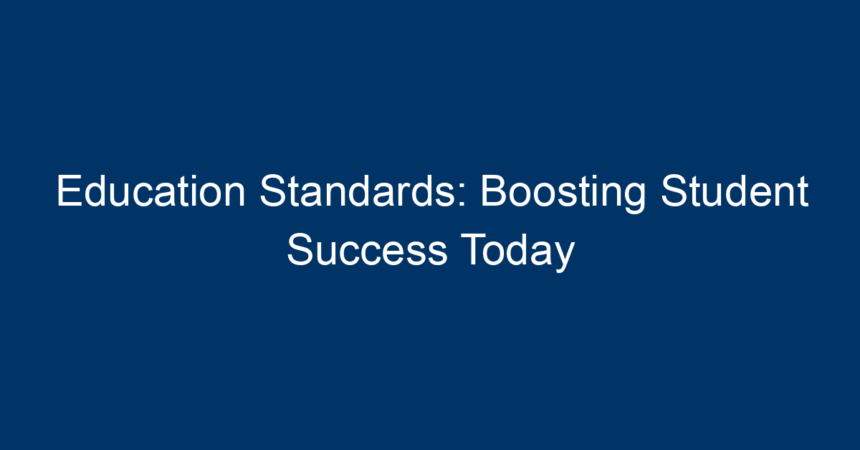In the rapidly evolving landscape of education, education standards serve as the backbone of academic systems around the globe. They define what students should know and be able to do at various stages of their education. With an ever-increasing emphasis on quality and accountability in education, establishing coherent and robust standards is crucial for fostering student success. In this article, we’ll delve into the significance of education standards, discuss the various types, and explore their direct impact on student outcomes and global competitiveness.
The Importance of Education Standards
Setting Clear Expectations
Education standards play a pivotal role in setting clear expectations for both educators and students. When standards are in place, teachers can tailor their instructional strategies to meet specific learning objectives, while students gain a clear understanding of what is expected of them. This clarity helps in reducing educational disparities, ensuring that all students, regardless of their background, have access to quality education.
Promoting Accountability
Another significant aspect of education standards is accountability. Schools, districts, and educators are held to specific criteria that gauge their effectiveness. This not only drives continuous improvement but also places emphasis on measurable outcomes. Accountability fosters a culture of excellence, motivating educators to pursue innovative teaching methods that enhance student engagement and learning.
Facilitating Educational Equity
Education standards aim to provide a level playing field for all students. By focusing on essential skills and knowledge, these standards help eliminate educational inequities that arise from socioeconomic disparities. Consequently, students from underprivileged backgrounds are given a chance to succeed, leveling the educational playing field and contributing to a more equitable society.
Types of Education Standards
Content Standards
Content standards define the knowledge and skills that students are expected to acquire in various subjects. These standards outline what students should learn at every grade level, guiding curriculum development and instructional practices. For instance, in mathematics, content standards specify concepts like fractions, geometry, and algebra that students should grasp at different stages of their education.
Performance Standards
Performance standards specify how well students must perform to demonstrate mastery of the content. These criteria often include assessment benchmarks, such as standardized test scores, which help evaluate student understanding. For example, a performance standard might state that by the end of fourth grade, students should be able to solve multi-step word problems, showcasing their analytical thinking and problem-solving abilities.
Achievement Standards
Achievement standards set the bar for what constitutes adequate performance in relation to established content and performance standards. This includes defining proficiency levels—such as basic, proficient, and advanced—allowing educators to assess the depth of student understanding comprehensively. These standards help identify students who may need additional support while highlighting those excelling.
The Impact of Education Standards on Student Success
Enhancing Learning Outcomes
Research shows that clear and rigorous education standards can significantly enhance student learning outcomes. When educators align their teaching methods with well-defined standards, students are more likely to grasp complex concepts, leading to improved academic performance. This alignment ensures consistent instruction across classrooms, promoting a coherent learning experience.
Encouraging Lifelong Learning
Education standards not only prepare students for immediate academic success but also instill a passion for lifelong learning. By emphasizing critical thinking, problem-solving, and adaptability, students develop skills necessary for their future careers. As industries evolve rapidly, students equipped with these competencies are more likely to thrive in a competitive job market.
Preparing for Global Competitiveness
In an age where globalization and technology dominate, education standards play a fundamental role in enhancing a nation’s competitiveness on the global stage. Countries with robust education standards tend to produce a workforce that is skilled, innovative, and adaptable. This, in turn, leads to economic growth and prosperity, benefiting society as a whole.
Challenges in Implementing Education Standards
Resistance to Change
One of the primary challenges in the implementation of education standards is resistance to change. Educators, parents, and administrators may be hesitant to embrace new standards due to fear of inadequate resources or training. This resistance can hinder the effectiveness of educational reforms, making it essential to foster a culture of collaboration and support.
Resource Limitations
Implementing effective education standards often requires significant financial and human resources. Schools may face constraints in terms of funding, professional development, and technological infrastructure. To overcome these limitations, policymakers must prioritize resource allocation to support educators and ensure that all students benefit from high-quality education.
Aligning Assessments with Standards
Another challenge lies in the alignment of assessments with established education standards. While standards set expectations for learning, assessments must accurately measure student performance against these criteria. This requires the design of comprehensive evaluation systems that integrate formative and summative assessments, providing a holistic view of student progress.
Actionable Insights for Policymakers and Educators
Foster Collaboration
To enhance the implementation of education standards, foster collaboration among educators, policymakers, and stakeholders. Establish forums for dialogue where experiences, challenges, and best practices can be shared. This collaborative approach will cultivate a sense of ownership and commitment to the standards.
Invest in Professional Development
Provide ongoing professional development opportunities for educators to ensure they remain well-informed about the latest developments in education standards. Training workshops, online courses, and mentoring programs can equip teachers with the tools needed to effectively implement the standards.
Utilize Data-Driven Decision-Making
Embrace data-driven decision-making to assess the effectiveness of education standards. Continuous monitoring and evaluation of student performance can provide insights into areas that need improvement or adjustment. Incorporate feedback from students, educators, and parents to refine standards and practices.
Advocate for Resource Allocation
Advocate for the allocation of resources that support the successful implementation of education standards. This includes funding for technology, materials, and training that can bolster educational efforts. Engaging community leaders and stakeholders can amplify support for these initiatives.
Conclusion
High-quality education standards are vital for fostering student success in today’s complex educational landscape. By setting clear expectations, promoting accountability, and enhancing learning outcomes, these standards help bridge gaps and prepare students for a successful future. While challenges in implementation exist, collaborative efforts, professional development, and data-driven decision-making can create a supportive environment conducive to excellence. As society continues to evolve, investing in effective education standards will undoubtedly pave the way for a brighter, more equitable future for generations to come.
In a world where education shapes futures, it is imperative to prioritize excellence in education standards for the success of every student. Let’s commit to this mission, creating pathways for a successful tomorrow.




